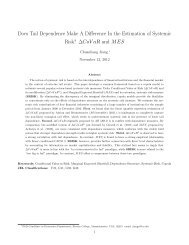Memory for specific visual details can be enhanced by negative ...
Memory for specific visual details can be enhanced by negative ...
Memory for specific visual details can be enhanced by negative ...
You also want an ePaper? Increase the reach of your titles
YUMPU automatically turns print PDFs into web optimized ePapers that Google loves.
E.A. Kensinger et al. / Journal of <strong>Memory</strong> and Language 54 (2006) 99–112 107<br />
<strong>specific</strong> recognition: Individuals might <strong>be</strong> less likely to<br />
<strong>for</strong>get an emotional item, and also more likely to<br />
remem<strong>be</strong>r the <strong>specific</strong> <strong>visual</strong> <strong>details</strong> of those items <strong>for</strong><br />
which they had some memory (see Burke et al., 1992).<br />
Another alternative, however, was that the effects of<br />
emotion on memory might <strong>be</strong> less pronounced at<br />
1000 ms than at 500 ms. Perhaps with the additional<br />
exposure to the neutral items, participantsÕ memories<br />
<strong>for</strong> those objects would <strong>be</strong> just as good as their memories<br />
<strong>for</strong> the emotional objects (i.e., emotional content<br />
might enhance memory <strong>for</strong> <strong>specific</strong> <strong>visual</strong> <strong>details</strong> only<br />
at intermediate presentation rates). A final possibility<br />
was that the effects of emotion on memory could <strong>be</strong><br />
comparable at the 500 and 1000 ms presentation rates;<br />
perhaps at both presentation lengths, emotion would enhance<br />
the likelihood of <strong>specific</strong> recognition, but would<br />
not influence the likelihood that at least some aspects<br />
of items were remem<strong>be</strong>red (i.e., would not influence general<br />
recognition).<br />
Method<br />
Participants<br />
Participants were 24 Harvard University undergraduate<br />
students (8 men and 16 women, mean age = 20.1,<br />
age range = 18–28), who met the same criteria as outlined<br />
in Experiment 1.<br />
Materials and procedure<br />
The materials were identical to those of Experiment<br />
1. The procedure was identical, except that the two presentation<br />
rates used at study were 500 and 1000 ms,<br />
rather than 250 and 500 ms as in Experiment 1.<br />
Results<br />
The data from Experiment 2 are presented in Table 2:<br />
The proportion of items given a ‘‘same,’’ ‘‘similar,’’ or<br />
‘‘new’’ response are listed as a function of item type<br />
(same, similar, or new), exposure duration (500 or<br />
1000 ms) and emotion type (neutral or <strong>negative</strong> arousing).<br />
To examine the effects of emotion on memory <strong>for</strong><br />
items studied <strong>for</strong> 500 and 1000 ms, we conducted ANO-<br />
VAs <strong>for</strong> the three different types of items presented on<br />
the recognition task: new items, items that were similar<br />
to studied items, and items that were the same as studied<br />
items.<br />
New items<br />
For the new items, an ANOVA indicated a main effect<br />
of response type (F(2,46) = 131.40, p < .0001, partial<br />
eta-squared = .85), and an interaction <strong>be</strong>tween<br />
emotion and response type (F(2,46) = 7.48, p < .01, partial<br />
eta-squared = .25). This interaction resulted <strong>be</strong>cause<br />
individuals were more likely to call a new item ‘‘new’’ if<br />
it was emotional than if it was neutral (t(23) = 3.24,<br />
p < .01), less likely to call a new item ‘‘similar’’ if it<br />
was emotional (t(23) = 2.34, p < .05), and marginally<br />
less likely to call a new item ‘‘same’’ if it was emotional<br />
(t(23) = 1.87, p < .08).<br />
Similar items<br />
For the similar items, an ANOVA revealed only a<br />
signifi<strong>can</strong>t main effect of response type (F(2,46) =<br />
20.36, p < .0001, partial eta-squared = .47), but no effect<br />
of presentation rate or emotion, nor any signifi<strong>can</strong>t<br />
interactions. As expected, when separate ANOVAs were<br />
conducted on the items with a 500 or 1000 ms exposure<br />
duration, the analyses indicated only a main effect of<br />
response type (F(2,46) = 17.08, p < .001, partial etasquared<br />
= .43 <strong>for</strong> the items presented <strong>for</strong> 500 ms;<br />
F(2,46) = 17.78, p < .001, partial eta-squared = .44 <strong>for</strong><br />
the items presented <strong>for</strong> 1000 ms), but no interaction<br />
<strong>be</strong>tween response type and emotion (partial etasquared<br />
< .07). Thus, just as in Experiment 1, individuals<br />
were more likely to la<strong>be</strong>l a similar item ‘‘similar’’<br />
than they were to la<strong>be</strong>l it ‘‘same’’ or ‘‘new,’’ and this<br />
pattern of responses to the similar items was not affected<br />
<strong>by</strong> the emotional content of the items.<br />
Same items<br />
An ANOVA conducted on the same items indicated a<br />
signifi<strong>can</strong>t effect of response type (F(2,46) = 13.56,<br />
p < .0001, partial eta-squared = .37), as well as interac-<br />
Table 2<br />
Experiment 2: Responses (mean, SE) <strong>for</strong> neutral and emotional objects as a function of item type (same, similar, or new), exposure<br />
duration (500 or 1000 ms), response type (‘‘same,’’ ‘‘similar,’’ or ‘‘new’’) and emotion type (neutral or <strong>negative</strong> arousing)<br />
Response Same 500 ms Similar 500 ms Same 1000 ms Similar 1000 ms New<br />
Neutral<br />
‘‘Same’’ 0.38 (.03) 0.14 (.02) 0.42 (.03) 0.19 (.02) 0.07 (.01)<br />
‘‘Similar’’ 0.36 (.03) 0.49 (.04) 0.34 (.03) 0.49 (.04) 0.34 (.03)<br />
‘‘New’’ 0.26 (.04) 0.36 (.05) 0.24 (.03) 0.31 (.04) 0.59 (.03)<br />
Negative arousing<br />
‘‘Same’’ 0.44 (.03) 0.15 (.02) 0.53 (.03) 0.17 (.02) 0.06 (.01)<br />
‘‘Similar’’ 0.33 (.02) 0.52 (.04) 0.33 (.02) 0.49 (.04) 0.29 (.02)<br />
‘‘New’’ 0.23 (.03) 0.32 (.04) 0.15 (.02) 0.34 (.03) 0.66 (.02)

















